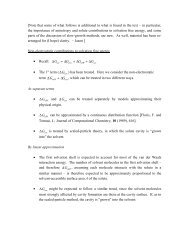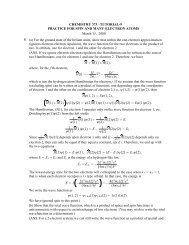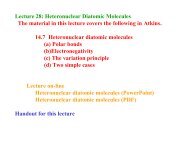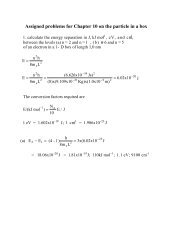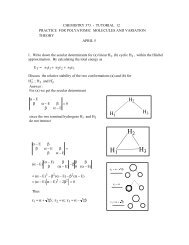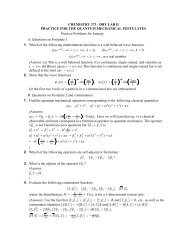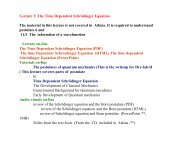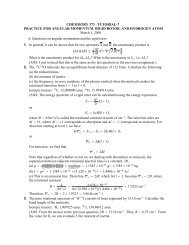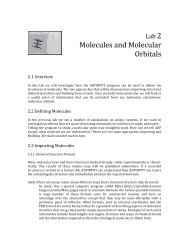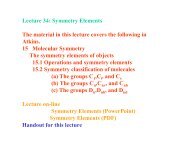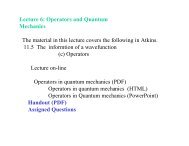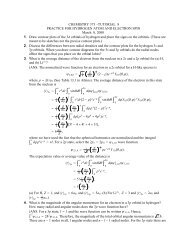Rigid Rotor and Angular Momentum - Cobalt
Rigid Rotor and Angular Momentum - Cobalt
Rigid Rotor and Angular Momentum - Cobalt
You also want an ePaper? Increase the reach of your titles
YUMPU automatically turns print PDFs into web optimized ePapers that Google loves.
6. Prove that2 k2 kLˆ ( Lˆ ψ ) = j( j 1)h ( Lˆ ψ −− j , j+for any nonnegative integer k such that ( j − k ) h ⎣ S( Lˆz) . Also, let s be a nonnegativeinteger such that ( j−s) h ∈S(ˆ L z ) but ( j− ( s+ 1)) h ∈S( L ˆ z ). Then show thatˆ 2 ( ˆ s, ) ( )( ) 2L L j s j s (ˆ s−ψjj= − − −1h L−ψjj, ),Now, using Eq. (1) <strong>and</strong> (2), show that the only values for j are 0, 1/2, 1, 3/2, 2, … .2(ANS. To do this Question, we need the results from the previous Question. Since Lˆ commutes Lˆ −, it commutes with any power of Lˆ −. Therefore, we can writeˆ 2 ( ˆ k) ˆ k( ˆ 2L L−ψjj, = L−L ψjj, ),ˆ k= L−( L ˆ − L ˆ + ψjj , + L ˆ z + h) ψjj, ),2 k= jj ( + 1) h (ˆ L−ψjj , ).2For the second equality, we choose the other expression for Lˆ . In addition, we shall needS + 1sss ssthe results (from class) that Lˆ −ψj , j= 0 , <strong>and</strong> [ Lˆz,Lˆ−] = − shLˆ−or LˆzLˆ−= Lˆ−Lˆz− khLˆ,−where s is a nonnegative interger. Therefore we can write2 sS + 1sLˆ ( L ψ ) = Lˆ Lˆ ψ + Lˆ ( Lˆ − h )( Lˆ ψ )−j , j= Lˆ= Lˆzz+−( Lˆ( Lˆs−Lˆs= ( j − s ) hLˆ( Lˆ ψ= ( j − s ) h(Lˆzzj , j( Lˆ ψs−− shLˆs−Lˆ)) − hLˆ) ψ− shLˆ= ( j − s )( j − s −1)hzj , jzzs−j , jzj , j= ( j − s ) h(j − s ) h(Lˆ ψ−− h(Lˆ) ψj , jLˆ) −(j − s ) hs−z).),s( Lˆ ( Lˆ ψs−j , j( Lˆ ψ2s−zj , j),− shLˆ−(j − s ) h) −(j − s ) hj , j−s−−j , jzj , j( Lˆ ψIn the first equality, set k = s, <strong>and</strong> then we have2 k2 sj(j + 1)h ( Lˆ ψ ) = ( j − s )( j − s −1)h ( Lˆ ψ −−j , j2s−s−j , j) ψ),s−j , js−( Lˆ ψ2,( Lˆ ψwhich means thatj(j + 1)= ( j − s )( j − s −1).This equation yields the quadratic equation in s2s −(2 j −1)s− 2 j = 0,which has two solutions s = 2j <strong>and</strong> s = -1. Since s must be a nonnegative integer, the secondroot is extraneous. Since s must be a nonnegative integer, then 2j must be a nonnegativeinteger. Therefore, j = 0, 1/2, 1, 3/2, 2, …)7. (Optional) Prove thatψ1⎡ 1 ( j+m)!⎤21jm , = ⎢( j)!( j−m)!⎥ j−m⎣ 2 ⎦ h− −jj ,(ANS. We start from the result given in classLˆψj mLˆ ψ .2= [( j + m )( j − m )] hψ− j ,m+1j ,m−11.2j , j),j , jj , j),),



